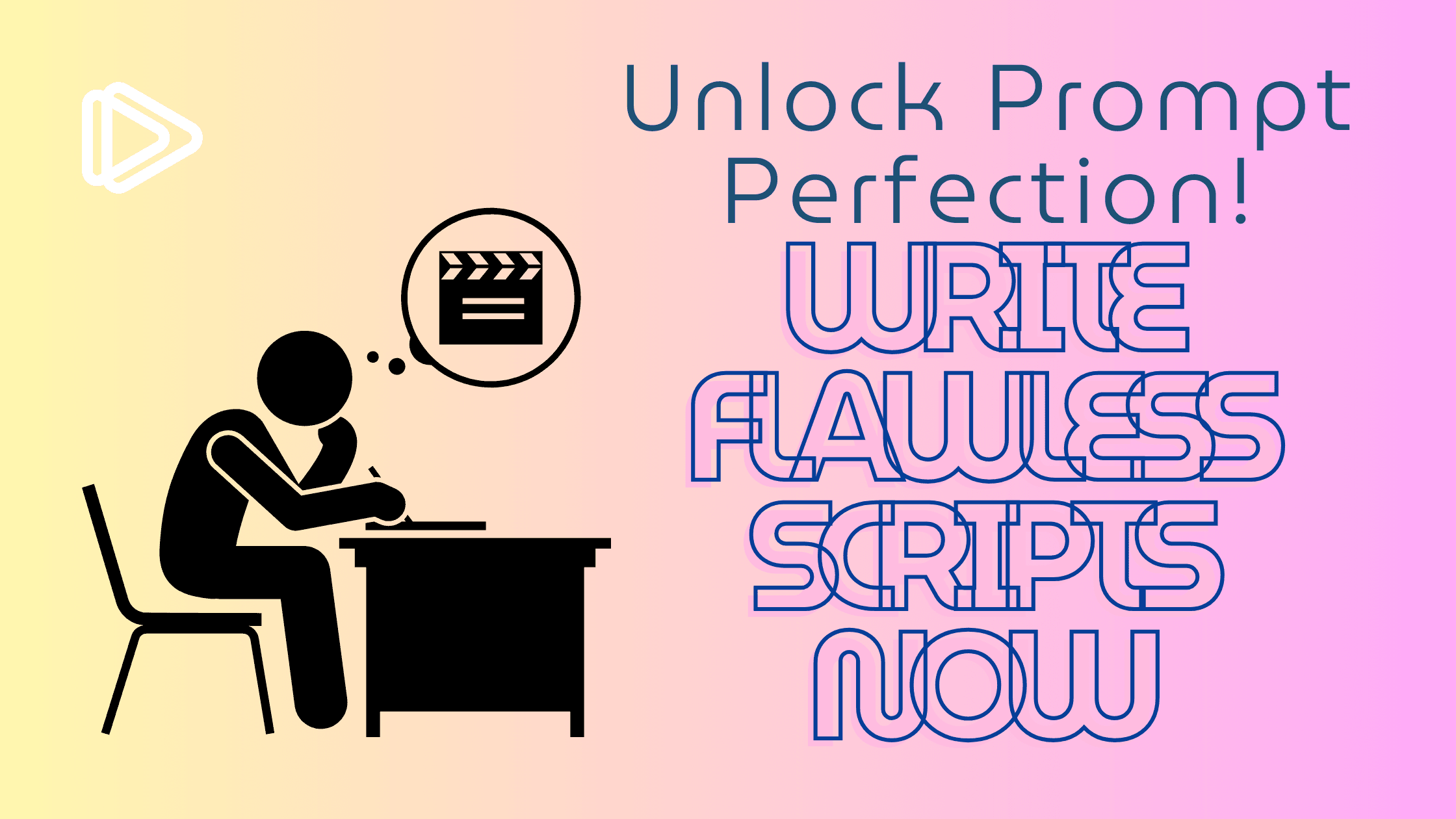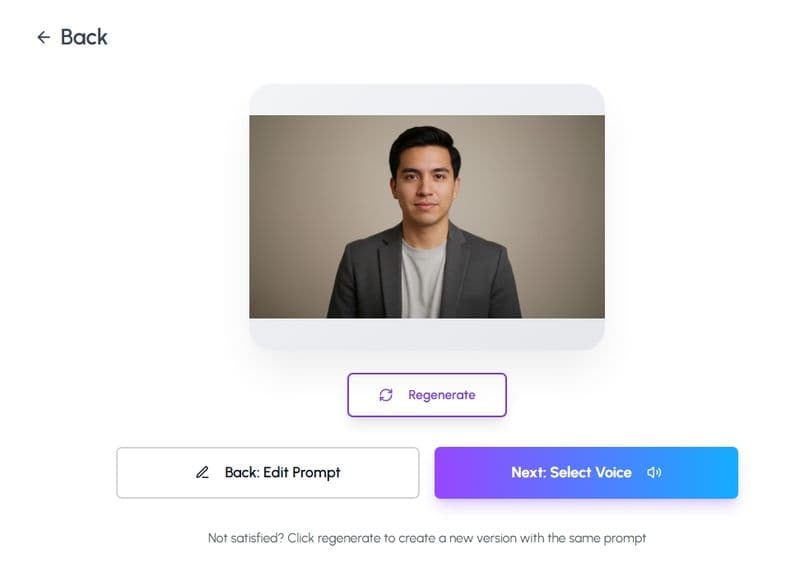
Writing a great script using an AI tool is not about getting it perfect on the first try! Professional-quality scripts often emerge through iterative prompt refinement, a process where you fine-tune your instructions step by step to create a natural, engaging, and effective script.
This guide will show you how to refine your prompts thoughtfully with reflective questions to help you think deeper at each stage. You will learn how to adjust tone, language, and creative elements for better results. Plus, you can apply these techniques using Personate AI’s 5 free credits to create your first AI-powered video script and see the difference prompt refinement makes.
What is iterative prompt refinement, and why does it matter?
Iterative prompt refinement involves continuously improving your prompt to get better results from your AI script writer. Think of it as coaching the AI to understand your vision more clearly each time you adjust your instructions.
Why it makes a difference:
Clarity improves results: The clearer your prompt, the better the AI can understand your goals.
Refinement drives creativity: Small tweaks can lead to big improvements in storytelling depth and emotional impact.
Faster results with fewer edits: Clear prompts reduce the need for multiple drafts.
Step 1: Start with a basic prompt (the idea stage)
Begin with a simple, clear prompt that outlines your script's purpose. This first draft is meant to establish the foundation, not deliver a perfect script yet.
✅ Basic prompt example:
"Write a 60-second script for a skincare product targeting women aged 30-50. Highlight hydration benefits and end with a call to visit the website."
Thinking questions to guide this step:
What is the core message I want this script to convey?
Who is my audience, and what do they care about?
What action should the audience take after watching this script?
Step 2: Identify areas for improvement in the AI's first draft
Once you have the AI's first output, review it critically. Look for areas where the language feels flat, robotic, or lacking emotional connection.
Common issues to spot:
Overly formal or too casual tone.
Lack of storytelling or creativity.
Generic descriptions with no sensory language.
✅ Refined prompt example:
"Write a 60-second script for a skincare product targeting women aged 30-50. Start with a relatable dry skin struggle, highlight hydration benefits using sensory language like ‘silky smooth’ and ‘radiant glow,’ and end with a CTA inviting viewers to claim a free sample."
Thinking questions to guide this step:
Does this script sound like something I would personally respond to?
What feels missing emotionally or visually?
Is the language connecting with the audience’s pain points or desires?
Step 3: Refine the prompt for better tone and word choice
Now, focus on guiding the AI to adjust the tone and word choice to better match your vision. If you are unsure of the right tone, try generating multiple versions for comparison.
✅ Refined prompt example for tone:
"Create a 60-second skincare ad script for women aged 30-50. Use a warm, conversational tone with sensory language like 'silky smooth' and 'glowing.' Avoid repetitive phrases and keep the language emotionally engaging."
Thinking questions to guide this step:
What emotion do I want the audience to feel while watching?
Does the tone match my audience’s lifestyle and preferences?
What words or phrases would make the message feel more personal and human?
Step 4: Add creative storytelling elements and emotional hooks
A script feels more engaging when it tells a story or evokes emotion. To avoid robotic language, guide the AI toward storytelling elements and emotional hooks.
Ways to enhance creativity:
Open with a personal story or pain point.
Use a hook: “Ever wake up with dry, uncomfortable skin?”
Add a CTA that inspires action: “Ready for healthier skin? Try it today.”
✅ Refined prompt example for creativity:
"Write a 60-second storytelling-driven script for a skincare product. Open with a personal anecdote about dry skin struggles, emphasize the product's hydration benefits using vivid language, and close with a motivational call to action."
Thinking questions to guide this step:
What personal story or challenge would my audience relate to most?
How can I capture attention in the first 5 seconds?
Does the script have a clear emotional arc from problem to solution?
Step 5: Test and compare multiple prompt versions
Iterative prompt refinement works best when you compare multiple drafts. Asking the AI to generate different styles or emotional approaches can help you find the perfect match for your audience.
Ways to test prompt variations:
Generate different tones: “Write three versions: one inspiring, one humorous, one factual.”
Try multiple story angles: “Create one focused on hydration benefits and another on self-care.”
Test different CTAs: “End with a CTA for free samples vs. a limited-time discount.”
✅ Refined prompt example for testing:
"Generate three versions of a 60-second skincare script for women aged 30-50. One should use a personal story, another should focus on product benefits, and the third should be motivational. Keep the language warm and inspiring."
Thinking questions to guide this step:
Which version feels the most emotionally powerful?
Does one version flow more smoothly than the others?
Which version’s CTA feels the most persuasive?
Step 6: Review and polish your final script
After reviewing multiple versions, merge the best elements into a final polished script. This ensures the final product feels human, emotionally engaging, and ready for production.
Final review checklist:
Is the message clear and easy to follow?
Does the language sound natural and conversational?
Is the emotional hook strong enough?
Does the CTA feel motivating?
✅ If the script still feels off, return to iterative prompt refinement by clarifying any weak points further in your prompt.
AI script prompt template for content creators (copy and customize)
Here is a reusable template you can modify to refine your AI prompts effectively:
"Write a [script type: explainer, ad, testimonial] for [target audience]. The tone should be [specific tone: friendly, emotional, professional]. Use sensory language to create vivid descriptions. Include storytelling elements and keep the script approximately [time or word count]. End with a motivating call to action that encourages [specific action you want the audience to take]."
Create professional video scripts and your first AI video with Personate AI
Perfecting your prompts through iterative prompt refinement is the key to unlocking natural, professional-quality AI scripts. Now you can apply this process using Personate AI’s 5 free credits to create your first AI-powered video and test your skills.
How to get started:
Craft your script: Use the steps and thinking questions shared above to refine your AI script prompt on Personate AI's script generator or platforms like ChatGPT.
Generate multiple versions: Adjust your prompt, test different styles, and compare drafts to find the best version.
Bring your script to life: Once you have a polished script, use Personate AI to create a professional-quality AI-generated video.
Polish and share: Fine-tune the final version and share your completed video with your audience.
✅ Sign up for Personate AI today and transform your content creation with AI-powered scriptwriting!


